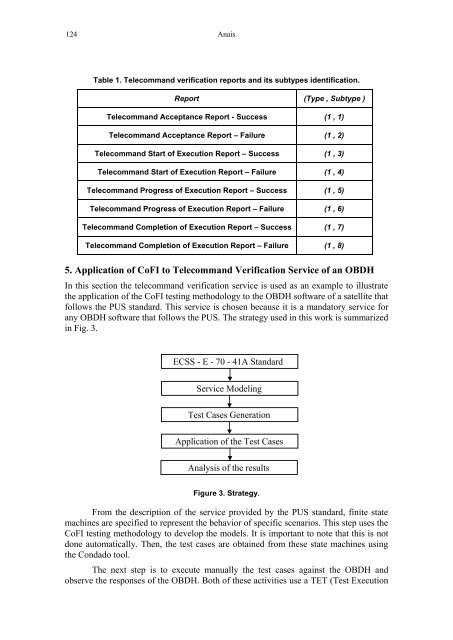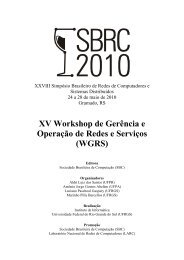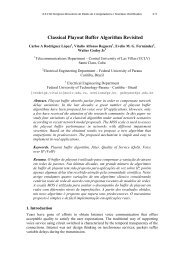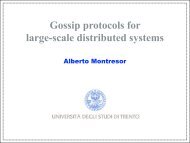XI Workshop de Testes e Tolerância a Falhas (WTF) - SBRC 2010
XI Workshop de Testes e Tolerância a Falhas (WTF) - SBRC 2010
XI Workshop de Testes e Tolerância a Falhas (WTF) - SBRC 2010
Create successful ePaper yourself
Turn your PDF publications into a flip-book with our unique Google optimized e-Paper software.
124 Anais<br />
Table 1. Telecommand verification reports and its subtypes i<strong>de</strong>ntification.<br />
Report (Type , Subtype )<br />
Telecommand Acceptance Report - Success (1 , 1)<br />
Telecommand Acceptance Report – Failure (1 , 2)<br />
Telecommand Start of Execution Report – Success (1 , 3)<br />
Telecommand Start of Execution Report – Failure (1 , 4)<br />
Telecommand Progress of Execution Report – Success (1 , 5)<br />
Telecommand Progress of Execution Report – Failure (1 , 6)<br />
Telecommand Completion of Execution Report – Success (1 , 7)<br />
Telecommand Completion of Execution Report – Failure (1 , 8)<br />
5. Application of CoFI to Telecommand Verification Service of an OBDH<br />
In this section the telecommand verification service is used as an example to illustrate<br />
the application of the CoFI testing methodology to the OBDH software of a satellite that<br />
follows the PUS standard. This service is chosen because it is a mandatory service for<br />
any OBDH software that follows the PUS. The strategy used in this work is summarized<br />
in Fig. 3.<br />
ECSS - E - 70 - 41A Standard<br />
Service Mo<strong>de</strong>ling<br />
Test Cases Generation<br />
Application of the Test Cases<br />
Analysis of the results<br />
Figure 3. Strategy.<br />
From the <strong>de</strong>scription of the service provi<strong>de</strong>d by the PUS standard, finite state<br />
machines are specified to represent the behavior of specific scenarios. This step uses the<br />
CoFI testing methodology to <strong>de</strong>velop the mo<strong>de</strong>ls. It is important to note that this is not<br />
done automatically. Then, the test cases are obtained from these state machines using<br />
the Condado tool.<br />
The next step is to execute manually the test cases against the OBDH and<br />
observe the responses of the OBDH. Both of these activities use a TET (Test Execution







